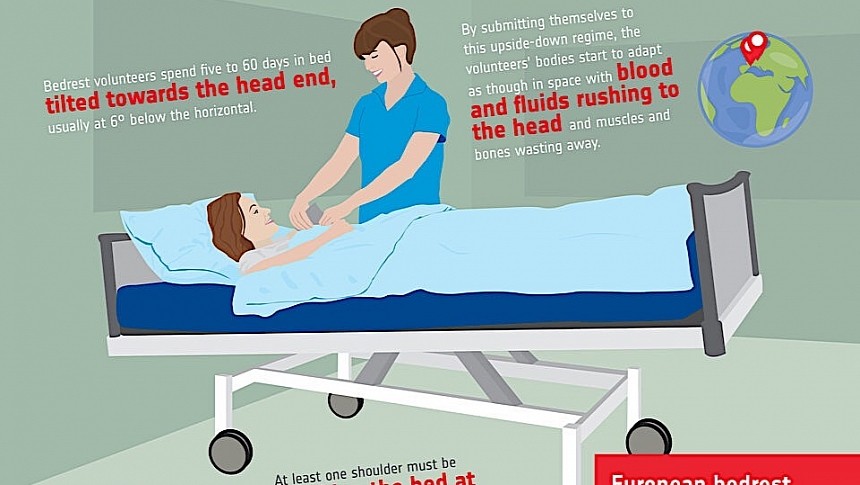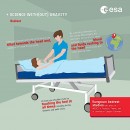We all know space exploration is not easy, and that long-time exposure to zero gravity may have unexpected results on the human body. But whereas for most of us this knowledge is more of an educated guess, for space agencies the effects of living in space on the body are a constant topic for research.
Presently, the title for longest continuous stay in space goes to Russian cosmonaut Valeri Polyakov. Back in 1994, he reached the Mir space station and didn't leave it for 437 days. That's impressive, but in the grand scheme of things, with the human race set to expand greatly in the solar system in the coming decades, not even close to what astronauts of the future will have to go through.
It's quite difficult for us to mimic the conditions in space here on Earth and study their effects on the human body, so workarounds have to be devised. The European Space Agency (ESA), for instance, will be using volunteers and long stays in bed, in an (almost) horizontal position, in a bid to test how "cycling could counteract the changes the human body experiences in space."
The study is called BRACE, which stands for Bed Rest with Artificial gravity and Cycling Exercise, and it's run by ESA with backing from the French Space Agency (CNES). Although the Europeans have been at it doing bed studies for more than two decades, this is the first time it also involves cycling. Confused? Let me explain.
12 people are currently in the process of conducting this experiment. The general rules for most of them are simple: they must stay in bed, with one shoulder always touching the mattress, for 60 days. The beds they're in are tilted to six degrees below the horizontal, with the feet of the participants pointing upwards.
This position of the bed makes blood flow to the head diminish, while not allowing the participants to move all that much will have the same effect on muscles. To prevent significant degradation, but also as a means to test said effects of cycling while in space, bicycles have been adapted to be used in bed. Aside for the bikes, there are also centrifuge devices designed to mimic artificial gravity and ready to spin the beds as needed.
Not all of the participants will get the same treatment. One group will get the full experience, meaning extended bed rest always on one side, the bikes, and the centrifuge. A second one, the control group, will only have to stay in bed.
The goal of the study is to "understand the added value of artificial gravity to the fitness routine astronauts follow on the International Space Station," but also find the impact of a daily exercise routine on a series of physiological factors. The findings of the study could also be used to advance the research into the use of artificial gravity in space. Closer to our time, it could lead to better treatments for various illnesses of the elderly here on Earth.
The current study will be followed by another one soon, focusing on "vibration exercise and artificial gravity."
It's quite difficult for us to mimic the conditions in space here on Earth and study their effects on the human body, so workarounds have to be devised. The European Space Agency (ESA), for instance, will be using volunteers and long stays in bed, in an (almost) horizontal position, in a bid to test how "cycling could counteract the changes the human body experiences in space."
The study is called BRACE, which stands for Bed Rest with Artificial gravity and Cycling Exercise, and it's run by ESA with backing from the French Space Agency (CNES). Although the Europeans have been at it doing bed studies for more than two decades, this is the first time it also involves cycling. Confused? Let me explain.
12 people are currently in the process of conducting this experiment. The general rules for most of them are simple: they must stay in bed, with one shoulder always touching the mattress, for 60 days. The beds they're in are tilted to six degrees below the horizontal, with the feet of the participants pointing upwards.
This position of the bed makes blood flow to the head diminish, while not allowing the participants to move all that much will have the same effect on muscles. To prevent significant degradation, but also as a means to test said effects of cycling while in space, bicycles have been adapted to be used in bed. Aside for the bikes, there are also centrifuge devices designed to mimic artificial gravity and ready to spin the beds as needed.
Not all of the participants will get the same treatment. One group will get the full experience, meaning extended bed rest always on one side, the bikes, and the centrifuge. A second one, the control group, will only have to stay in bed.
The goal of the study is to "understand the added value of artificial gravity to the fitness routine astronauts follow on the International Space Station," but also find the impact of a daily exercise routine on a series of physiological factors. The findings of the study could also be used to advance the research into the use of artificial gravity in space. Closer to our time, it could lead to better treatments for various illnesses of the elderly here on Earth.
The current study will be followed by another one soon, focusing on "vibration exercise and artificial gravity."






